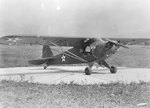L-4 Grasshopper
| Country | United States |
| Manufacturer | Piper Aircraft, Inc. |
| Primary Role | Reconnaissance Aircraft |
| Maiden Flight | 1 January 1938 |
Contributor: C. Peter Chen
ww2dbaseThe J-3 Cub aircraft were born from Piper Aircraft engineer Walter Jamouneau's changes to the existing J-2 design. Even before J-3 Cub aircraft went into production, war had already broken out in Asia, while armed conflict in Europe seemed imminent; thus, on 27 Dec 1938, President of the United States Franklin Roosevelt announced a Civilian Pilot Training Program ("CPTP") that would train civilians piloting skills in preparation of war, and J-3 Cub aircraft became the primary trainer aircraft of the program. Between 1938 and 1944, over 75 percent of 435,165 pilots who graduated from the program were trained in J-3 Cub aircraft. As the United States entered the war, civilian J-3 Cub aircraft patrolled both coasts of the United States, spotting for enemy submarines. Very soon, the United States military placed their order for J-3 Cub aircraft.
ww2dbaseThe military variant, with enlarged Plexiglas windows, was designated L-4 Grasshopper by the US Army and O-59/NE-1 Grasshopper by the United States Navy and Marine Corps. Grasshopper aircraft were used extensively for reconnaissance, transport of supplies, and evacuation of wounded. In the reconnaissance role, US Army cavalry officers such as Captain A. T. Netterblad used Grasshopper aircraft to detect enemy movements and to drop messages to his troops; there were talks to supply Grasshopper aircraft to all reconnaissance units of each division, but it never came to fruition. Some army Grasshopper aircraft were equipped with infantry rocket launchers to support ground troops, and they fulfilled their ground support missions effectively.
ww2dbaseProduction of J-3 Cub and L-4/O-59/NE-1 Grasshopper aircraft continued until 1947; a total of 19,073 were built during the design's production life, most being the L-4 variant. At the height of demand, one aircraft was built every 20 minutes. A few remained in service with the US Army through the Korean War, though most were scrapped or sold to the civilian market as surplus.
ww2dbase
ww2dbaseSources: Steeds of Steel, Wikipedia.
Last Major Revision: Jun 2008
SPECIFICATIONS
J3C-65
| Machinery | One Continental A-65-8 air-cooled flat four engine rated at 65hp |
| Crew | 1 |
| Span | 10.74 m |
| Length | 6.83 m |
| Height | 2.03 m |
| Wing Area | 16.58 m² |
| Weight, Empty | 345 kg |
| Weight, Maximum | 550 kg |
| Speed, Maximum | 140 km/h |
| Speed, Cruising | 121 km/h |
| Rate of Climb | 2.30 m/s |
| Service Ceiling | 3,500 m |
| Range, Normal | 354 km |
Photographs
 |  |  |  |
Please consider supporting us on Patreon. Even $1 per month will go a long way! Thank you. Please help us spread the word: Stay updated with WW2DB: |
Visitor Submitted Comments
7 Jun 2011 10:42:49 AM
Any idea as to the takeoff distance of the L-4 Grasshopper.
19 Apr 2014 06:43:43 PM
Anyone have an idea where full scale plans could be found for the L-4? A recreation would be a wonderful plane for a military enthusiast.
18 Oct 2018 01:41:22 PM
Your description of the use of the L-4 Grasshopper is very true, however the real value to the U.S. Army during WWII, especially in Europe, was the capability of the L-4 pilot to accurately direct artillery fire. I know this because my father was one of those brave L-4 pilots.
15 Dec 2020 11:51:08 AM
Are there full scale plans that can be bought for an L4?
All visitor submitted comments are opinions of those making the submissions and do not reflect views of WW2DB.
- » US Women's Army Corps "Six Triple Eight" Awarded with Congressional Gold Medal (30 Apr 2025)
- » Wreck of Soviet Submarine M-49 Found (10 Apr 2025)
- » Japanese Emperor Visited Iwoto (Iwo Jima) (8 Apr 2025)
- » Race, Holocaust, and African-American WW2 Histories Removed from the US Naval Academy Library (7 Apr 2025)
- » US Government Plans to Purge WW2 Information (17 Mar 2025)
- » See all news
 |
- » 1,167 biographies
- » 337 events
- » 44,615 timeline entries
- » 1,244 ships
- » 350 aircraft models
- » 207 vehicle models
- » 376 weapon models
- » 123 historical documents
- » 261 facilities
- » 470 book reviews
- » 28,518 photos
- » 365 maps
Fleet Admiral Chester W. Nimitz, 16 Mar 1945
Please consider supporting us on Patreon. Even $1 a month will go a long way. Thank you!
Or, please support us by purchasing some WW2DB merchandise at TeeSpring, Thank you!
30 Jan 2011 01:38:31 PM
Looking for some plans for the grasshopper light observation plane. I plan on building a model in the 1:87 and 1:160 scales if I find plans.
Any help out there?
JIM